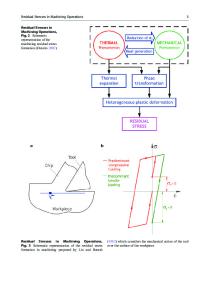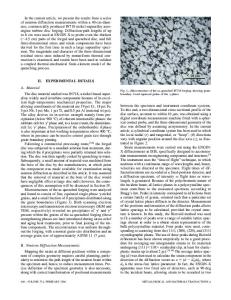Modeling Concentration of Residual Stresses and Damages in Salt Rock Cores
- PDF / 742,121 Bytes
- 8 Pages / 612 x 792 pts (letter) Page_size
- 97 Downloads / 396 Views
_____________________________ GEOMECHANICS _______________________________ ____________________________________________________________________________________________________________________________________
___________________________________________________________________________________________________________________________
Modeling Concentration of Residual Stresses and Damages in Salt Rock Cores V. N. Aptukova,b* and S. V. Volegovb a
Galurgiya JSC, Perm, 614002 Russia *e-mail: [email protected]; [email protected] b Perm State National Research University, Perm, 614000 Russia Received February 20, 2020 Revised March 13, 2020 Accepted May 29, 2020 Abstract—The authors perform numerical modeling of processes which create individual history of mechanics and mechanical condition of salt rocks nearby a roadway. The influence of a sampling point (roof or sidewall) and life time of the roadway on the residual stress level and quality of a sample is estimated with regard to microinhomogeneity. The effect of the specified factors on the mechanical characteristics of a sample in standard compression testing is demonstrated. Keywords: Salt rocks, structurally inhomogeneous sample, residual stresses, mathematical modeling, quality. DOI: 10.1134/S1062739120036806
INTRODUCTION
The experimental data on physical and mechanical properties of salt rock samples taken from cores of geological boreholes and by drilling additional holes from roadways are of great importance in designing and operating salt mines. These additional holes allow compiling local mechanical characteristics, which help to update the current parameters of stopes and take actions to maintain permanent roadways, choose the types and parameters of support. The salt rocks nearby a roadway are in an elastoplastic state and undergo structural changes over time due to creep processes under rock pressure and additional stress concentration. Together with the structural microinhomogeneity of rocks (mineral aggregate of grains with different mechanical properties, clay inclusions, pores), these changes are reflected in the mechanical characteristics of the rock mass in the vicinity of the mine. In addition, core samples become unloaded in the course of preparation, as a result of which the field of residual stresses and damages is formed. For a long time of its existence in the massif, the rock of a sample tested in laboratory conditions is exposed to nonuniform external loads. These loads form the individual history (memory) of a given sample. Salt beds in the massif are in equilibrium. A complex stress state is formed in them due to rock pressure [1]. Salt rocks are mineral aggregates consisting of irregular grains of various sizes (with different mechanical properties), grain boundaries, other inclusions, and pores containing gases and liquids. If the field of macroscopic stresses is homogeneous, local complex mineral structure creates a structurally inhomogeneous stress field with fluctuations at the level of characteristic grain size, which leads to
Data Loading...











